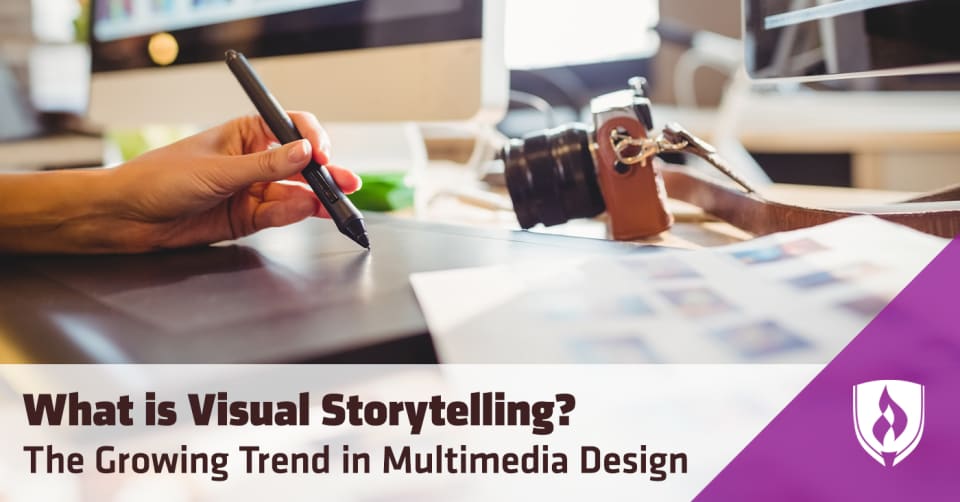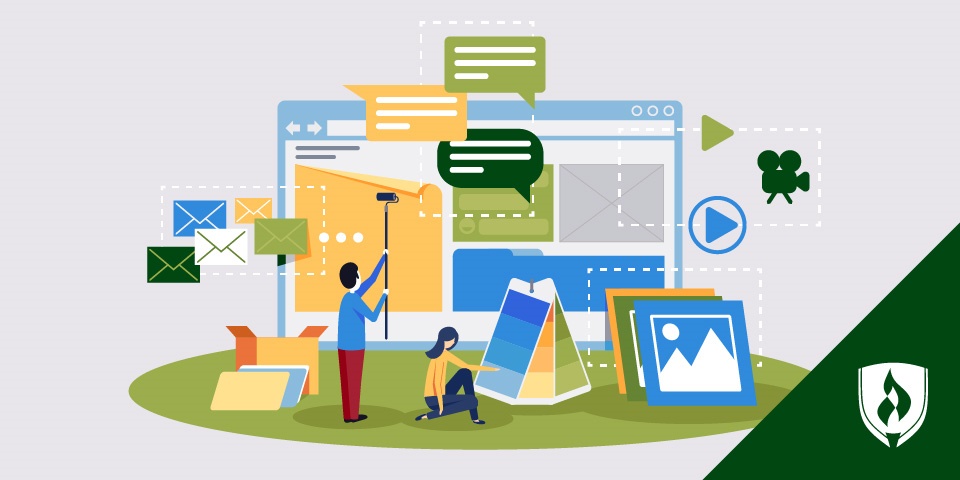
It’s common for budding designers to perk up their ears when they hear established designers or design companies discussing what the next big industry trend will be. In 2014, it was bold typography and interactive templates. Then came the minimalist movement, flat mobile-friendly design and then parallax scrolling the year after.
So what’s next?
Designers everywhere have been talking about visual storytelling. From animated GIFs to snazzy infographics and even real-time storytelling through platforms like Periscope, visual storytelling is everywhere. In fact, it was named the “big trend” at the 2016 South by Southwest Interactive conference.
All indications suggest this is a design trend with some major staying power, so you’d be well-served to learn all you can about it now! Here’s what you need to know.
What is visual storytelling?
By definition, visual storytelling might seem pretty straightforward — it’s the art of communicating a series of messages using visual multimedia. The concept isn’t new to our cultural landscape. In fact, the phrase “A picture is worth a thousand words” was coined just after the turn of the 20th Century.
But the concept of visual storytelling is more relevant now than ever, especially in light of our highly digital age in which there is a constant battle for consumers’ attention.
Today’s visual storytelling involves the use of graphics, images, pictures and videos to engage with viewers in an effort to drive emotions and interaction. These are tactics marketers have been tuned into for years, but with the rapid rise in digital marketing, they’re now calling upon designers like you to bring their messages to life.
Talented designers are essential in presenting data and messaging in visual formats, which is critical to visual storytelling. Once they have all the necessary details, designers are tasked with turning information into relevant, informative, eye-catching pieces of art . Chief among these formats is video, but visual storytelling can include everything from compelling photojournalism and educational infographics to cutting-edge comics, GIFs and memes.
Visual storytelling isn't about pairing a piece of content with an image; it’s about determining the right way to represent the information to ensure that it is compelling and relevant for the right audience. When the visual aspect is at its most powerful, the impact and performance of the content is magnified.
Why is visual storytelling so important?
We can discuss the importance of visual storytelling all day, but what do the facts show? Studies have revealed some pretty alarming statistics about the true impact of visual content:
- The brain processes visuals 60,000 times faster than it does plain text
- Content with relevant images gets 94 percent more views than content without
- Nearly 66 percent of updates on social media are visual content
- Tweets with images receive 150 percent more retweets
- Approximately 100 million internet users watch at least one online video each day
- 46.1 percent of consumers judge a company’s credibility based on its website design
Visual content is not only more eye-catching and memorable, but it’s more engaging for its audience, which heightens its credibility, bolsters the brand and increases revenue for the company that commissioned it. This makes finding top-notch designers a high priority for companies of all kinds!
In the midst of a culture so saturated with images and videos, if you’re not up-to-date on visual storytelling, you’re already several steps behind competing designers looking to make some headway in the industry.
What kind of visual storytelling makes the biggest impact?
All forms of visual storytelling usually provide credible statistics, but it shouldn’t surprise you that video is king when it comes to the most impactful format. While video may be king, it’s not the only type of visual storytelling audiences want. Regardless of format, all forms of visual storytelling should adhere to a few important principles.
NewsCred and Getty Images teamed up to identify what they’re calling “The Four Principles of Visual Storytelling.” Here is a brief run-down to help you improve your visual storytelling capabilities as you gear up for a healthy design career:
1. Authenticity
Immersed with so much content on a daily basis, audiences have become more sophisticated when it comes to spotting fake or sponsored content. The lesson here for designers is to remain authentic if you want to establish a personal connection with viewers.
2. Sensory
With such a high percentage of our waking hours spent online, audiences have become somewhat desensitized to digital content. For this reason, viewers have become more and more drawn to visceral, sensory experiences. The more senses a piece of visual content is able to engage, the more memorable it becomes.
3. Archetype
Creating character-driven visual stories helps an audience establish a personal connection with the message being shared. You may be familiar with some of the most classic archetypes, such as the caregiver, the explorer, the hero and the rebel. These become powerful tools in delivering the right visuals to the audiences that will identify with them most.
4. Relevancy
A key to connecting with an audience is providing the right message at the right time through the right visual representation. Tapping into cultural events, timely occurrences and emerging trends is vital to relevant visual storytelling.
How can I stay on the cutting edge of this growing design trend?
Visual storytelling is a trend that has been around for decades, and it’s not going anywhere anytime soon. The key is learning how to keep up with its critical evolution in the midst of a constantly-evolving digital landscape.
As a budding designer, one of the best things you can do to ensure a long and healthy career is to stay on top of trends and ahead of the crowd in your design portfolio. You can learn more about visual storytelling by reviewing the dozens of compelling examples from top designers, but there are some elements of design that can be hard to happen upon when you’re flying solo.
Here are seven things veteran graphic designers think self-taught designers are missing.
RELATED ARTICLES:
- The Graphic Designer's Guide to the Psychology of Color
- Is a Graphic Design Degree Worth It or Worthless?
- Everything You Need to Know About Becoming a Motion Graphics Designer
- Designers Weigh In: Why Does Everyone Hate Comic Sans So Much?
- Is Graphic Design Hard? Designers Dish on the Most Difficult Aspects of the Job
- 8 Great Creative Careers for Introverts
- Get Competitive: 7 Tech Skills & Certifications for Graphic Designers




